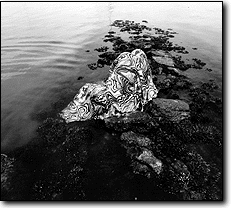![[ ARTS
]](/images/fall97/artsublogo.gif)
Arizona Summer Wildcat July 8, 1998
Diving deep
![[Picture]](12_1_i.gif)
|
Wildcat File Photo
"Shrouded: Rockness," by Ann Simmons-Myers, is part of "Immersions," on display at the University of Arizona Museum of Art through Aug. 9.
|
Arizona Summer Wildcat
All the explanations for "Immersions," the current exhibition on display at the University of Arizona Museum of Art, say it "surfaced three years ago in a swimming pool."
Swimming pools are incredibly strange. Cement holes in the ground are filled with chemicals and a little bit of water in which people are supposed to soak themselves for pleasure and leisure. So this exhibit seemed all the more interesting. Pools as art, like David Hockney in the '70s. It's really all they're good for - post-modern wastelands with lifeless figures standing rigidly aside. That's what I was expecting.
"Immersions" has nothing to do with swimming pools. It's more bodies of water: oceans, lakes, rivers, above and below the surface.
Which goes to show you shouldn't have these prefab expectations before you go see an art exhibit.
Half of the exhibit is by Ann Simmons-Myers, the other, by David Andres. Both artists are local and UA alumni. They've known each other for 20 years, and the exhibit was born out of the trips to Mexico and other regional water-areas that their families have taken together. Simmons-Myers does photography, and Andres does acrylic paintings on canvas, so the exhibit has black and white photographs with these huge, colorful paintings in between. It's like calm water then Class 2 rapids, like swimming with your head above water and then diving under and opening your eyes.
Andres' paintings go below the surface and depict life as seen underwater. Swirling colors and blobs and organic shapes all overlain with glitter, floating with the current. From up close, the pictures are soft, almost blurry, but as I sat on a bench on one side of the gallery, "Isolation," one of Andres more recent works, sharpened up and almost began to move, like when you have colors that contrast and complement each other so much they shake. His work is taken largely from his scuba diving experiences, except what he paints aren't fish shapes or even seaweed shapes - it's the algae and the protozoa, the itty bitty bacterium floating freely in the water, magnified into these Technicolor abstractions. It's like a surreal aquarium window inside an art gallery; the little microorganisms taken out of the water and put under a microscope, except there's no microscope. Huge strange-shaped figures bobbing up and down in the water, in a foreign environment wearing manufactured clothes made out of artificial material.

Dispersed between these paintings are Simmons-Myers' photographs, all from a series called "Shrouded." Each photo has three essential elements: there's something, usually a person, draped in a shroud, either wet or partially submerged in a body of water, photographed from above. The forms sometimes fall back into the scenery, which is usually very close to an ocean or lake, more than likely Puerto Peö#241;asco, Lake Powell or the San Pedro River, becoming almost part of it. It takes a couple looks back at each photo before you realize that there's actually a person there - or that there's a sheet covering part of a ledge or a rock. One photo, "Rockness," is of a hand-puppet in the foreground with rocks and cliffs and the ocean in the background.
Not swimming pools by any means. It's much more natural and meditative than that, the kind of art that makes you ask questions: Where did she get that shroud that looks like a snake? It must be incredibly sticky and humid under that wet cover. How many times did that girl have to curl up in the water and hold her breath, and how long did she have to hold her breath while Simmons-Myers took the photograph? The kind of art you stare at: Andres' paintings have that ambiguous landscape to them, that cloudy-sky quality - maybe you see a big spaceship shooting paintballs at lizards, or maybe a dinosaur eating bagels.
"Immersions" runs through Aug. 9. The University of Arizona Museum of Art is open Monday through Friday, from 10 a.m.-3:30 p.m. and Sunday from noon-4 p.m.



